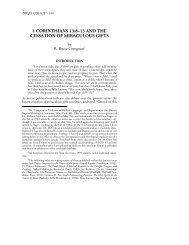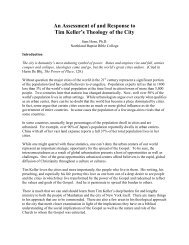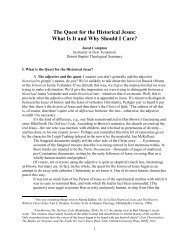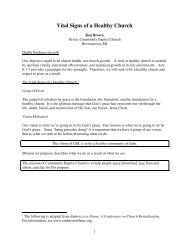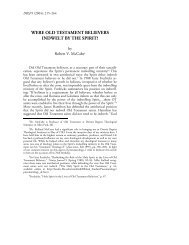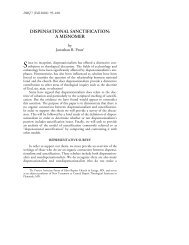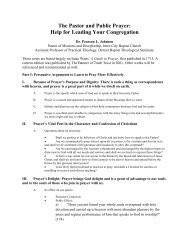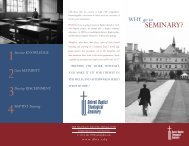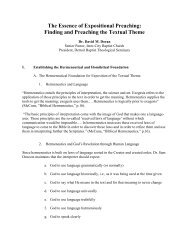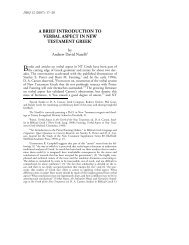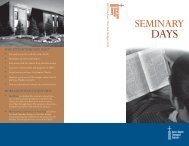Samuel A. Dawson - Detroit Baptist Theological Seminary
Samuel A. Dawson - Detroit Baptist Theological Seminary
Samuel A. Dawson - Detroit Baptist Theological Seminary
- No tags were found...
You also want an ePaper? Increase the reach of your titles
YUMPU automatically turns print PDFs into web optimized ePapers that Google loves.
The Dual Nature and Dual Consciousness of Christ 173the Trinity, but the theanthropic person (God-man) did not exist. “Jesus”did not exist until the Logos assumed into his person a humannature derived from a human mother at the incarnation. It was onlythen, in fulfillment of prophecy, that Mary called his name “Jesus.”Moreover, at the incarnation the Logos assumed into his personan unindividualized human nature. 27 We would not address the humannature which Christ assumed before the incarnation as “you.” 28Rather, we address it as a part of the lump of clay called humanity,unindividualized at this point.The human nature which Christ assumed at his incarnation didachieve personal existence, but only in the person of the Eternal Son. Itdid not gain its own unique personhood distinct from the Logos; instead,this genuine human nature, having all the properties pertainingto a human nature, was personalized in the Second Person of the Trinity.29 Thus, it became fully functioning and individualized in the Godman.The Logos, then, changed only by addition, not conflation. Headded to himself a human nature, which was personalized through hisown person and included a human consciousness. 30 As a result, the27 Personality, then, is not an essential part of a genuine human nature.28 Christ did not assume a human person, with the divine person taking over atincarnation, or we have a form of Nestorianism. Contra Erickson, Christian Theology,pp. 748–49. I agree with Murray that “the very notion of personality can never bepredicated of [the incarnate Son] except as it draws within its scope his specificallydivine identity. And if this is so, it is not feasible to speak of his ‘human personality’”(John Murray, review of D. M. Baillie, God Was in Christ, in Collected Writings of JohnMurray, 4 vols. [Edinburgh: Banner of Truth, 1976–1982], 3:343).29 At incarnation, the essence of the Trinity did not change so that the Trinity’sessence now contains both a body and a soul. Rather, the essence of the Trinity remainsthe same, with the Second Person of the Trinity remaining an equal part of theone essence. The Son of God did not assume a human nature into the unity of Trinity.Instead, the Second Person of the Trinity, Himself, assumed a human nature andpersonalized it in the unity of his own person (see Shedd, Dogmatic Theology, p. 641,supplement 5.1.1).30 One may ask whether this human nature, personalized through the Logos, hasa legitimate human consciousness or not. If in its unindividualized form it is not personal,then when did its human consciousness come into existence, if it did? We answerthis question by first noting that one of the attributes of a fully operatingpersonalized human nature is consciousness. For example, plants do not enjoy consciousness.God, carefully, distinguishes between plants and animals/man during Hisaccount of creation. Animals and men are called “living creatures” or “living-souls”(Gen 1:20–21, 24; 2:7), while plants are not referred to in this way. I propose that thedifference between plants and animals is that plants do not have an awareness of physicallife. Thus, a plant’s nature does not enjoy the property of consciousness. Animallife does, but its consciousness terminates in an awareness of the physical, while a humannature’s consciousness expands to include physical, spiritual, moral and rationalpowers. A genuine, individualized human nature, then, has a consciousness that is



